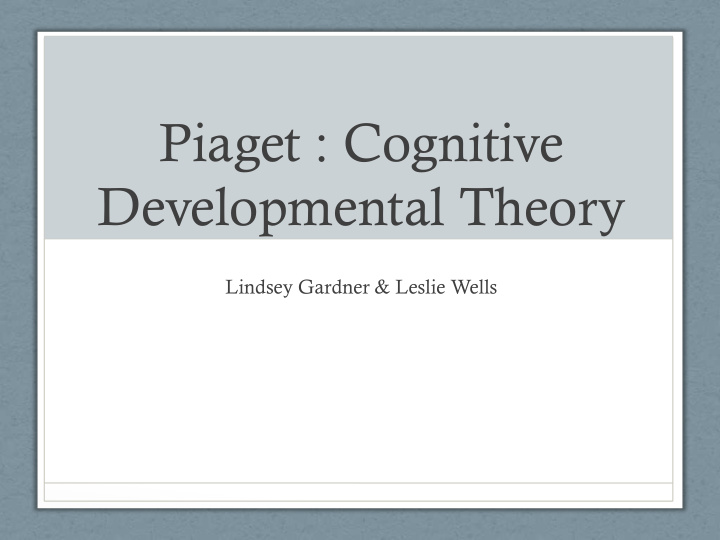



Piaget : Cognitive Developmental Theory Lindsey Gardner & Leslie Wells
Historical Influences Jean Piaget • • Passion for Biology • “Big Three” Immanuel Kant • • Categories, Schemata, & Constructivism Herbert Spencer • • Synthetic Principle • Ontogeny Recapitulates Phylogeny • Equilibration Heinz & Flavell • • Popularized Piaget in U.S. Jean Piaget
Internal Principles • Assimilation • Accommodation • Equilibration Clip Art All Activity can be characterized by two opposing tendencies- Assimilation & Accommodation
Assimilation • Assimilation: the tendency toward self-preservation and the incorporation of environmental sensations into the activities and systems already possessed by an individual • Making it “fit” • Example: Children “cooking” in their play kitchen.
Accommodation • Accommodation: the complement to assimilation; it entails adjustments the individual makes to the real world
Equilibration Constructivist paradigm • Balance between assimilation • and accommodation One of Piaget’s most important • concepts A process in which assimilation and accommodation are brought into balance
Functional Invariants • Organization • Adaptation • Assimilation • Accommodation • “It is by adapting to things that thought organizes itself and it is by organizing itself that it structures things.” – Relationship between four key Piagetian concepts. Piaget, 1963
Principles • Schema • Schemata • Cognitive Operations • Appear between 7 and 8 years • Operative & Figurative Aspects of Knowledge • Figurative: Touch, Smell, Hearing, Vision, Taste • Operative: Classification, Order, Composition, Arrangement • Cognitive Structures • “stages”
Cognitive Structures • Includes: • Sensorimotor stage • Preoperational stage • Concrete Operational stage • Formal Operational stage • Very Important • 3 Main Features of Stages “The difference between one cognitive stage and another is not a matter of knowing more; it is a difference in cognitive structure that a child applies to makings sense of the world” –Green & Piel (2010) p. 311
Sensorimotor stage • Ages Birth – 2 (with six substages) • Sub-stages 1 through 3 o Reflex o Differentiation o Coordination • Sub-stages 4 through 5 (8-12 mo.) o Object permanence o Intention • Sub-stage 6 o Mental representation o Internalization clip art photo
Preoperational stage • Ages 2 – 7 or 8 • Semiotic (Mental Functions) • Narrow Field of Attention • Immaculate Perception • Subjective Egocentrism • Animism & Artificialism • Transductive Reasoning
Concrete Operational stage • Ages 6 or 7 – early adolescence + • Creates rational thought, cannot think abstractly • Concrete • Cognitive Reversibility • Logical Operations of Classification & Relationship • Concept of Numbers
Formal Operational stage • Ages 12 to 14 – adulthood • Reorganizes concrete to propositional logic • Hypothetical-Deductive Reasoning • Multivariate Thinking • Recursive Thought • Subordination of Reality to Possibility
Change Mechanism • Biological Maturation • Physical Experience • Logico-mathematical Experience • Social Transmission • Equilibrium Clip Art photo
Validity and Adequacy Developmental Adequacy Scientific Validity • Temporality • Testability • Cumulativity • External Validity • Directionality • Predictive Validity • Increased Complexity • Internal Consistency • New Mode of Organization • Theoretical Economy • Increased Capacity for Self- Control
Application • Interpretability • Versatility • Availability • Guidance Clip Art photos
The End! Any Questions?
References (picture) Accommodation (2013). Retrieved November 1, 2015 from A.Dizon http://ms- dizon.blogspot.com/ 2013/05/assimilation-vs-accommodation.html (picture) Assimilation (2013). Retrieved November 1, 2015 from A.Dizon http://ms- dizon.blogspot.com/2013/05/ assimilation-vs-accommodation.html Baillargeon, R. (2004). Infants’ physical world. Current Directions in Psychological Science, 13, 89-94. Baillargeon, R., Stavans, M., Wu, D., Gertner, R., Setoh, Pl, Kittredge, A.K., & Bernard, A. (2012). Object individuation and physical reasoning in infancy: An integrative account. Language Learning and Development, 8 , 4-46. (picture) Concrete operations. (n.d.) Retrieved November, 1, 2015 from Mind 2 Matters online modules http://www.ablongman.com/html/mindmatters2/html/m7/m714.html DeVries, R., Zan, B., & Hildebrandt, C. (2002). Issues in constructivist early moral education. Early Education And Development 13 , 313-343. doi:10.1207/s15566935eed1303_5 (picture) Equilibration. (2015). Retrieved November 1, 2015 from Haikudeck https://www.haikudeck.com/piagets-reflection- education-presentation-gHYu52upTH Flavell, J. H. (1963). The development theory of Jean Piaget. New York, NY: D. Van Nostrand. Green, M., & Piel, J. A. (2010). Theories of human development. Boston, MA: Pearson
References Cont. Jenning, H. (2007). Conservation task. Retrieved from: https://www.youtube.com/watch?v=YtLEWVu815o Kohler, R. (2008 ). Jean Piaget . London, England: Bloomsbury. Piaget, J. (1962). Play, dreams and imitation in childhood. New York, NY: Norton. Piaget, J. (2002). Judgment and reasoning in the child. [electronic resource] . London: Routledge. Piaget, J. (2007). The construction of reality in the child [electronic resource] Jean Piaget . Oxfordshire, England: Routledge. (picture) Preoperational stage of development. (2013). Retrieved November 1, 2015 from the sociologycanvas Wiki http://sociologycanvas.pbworks.com/w/page/61769206/Preoperational%20stage%20of%20development ProfKelley. (2012, September 25). Illustration of schema, assimilation, & accommodation [Video File]. Retrieved from https://www.youtube.com/watch?v=3-A9SgbAK5I (picture) Proportional reasoning. (2014). Retrieved November 1, 2015 from Wikipedia https://en.wikipedia.org/wiki/Proportional_reasoning Wang, S., Baillargeon, R., & Brueckner, L. (2004). Young infants’ reasoning about hidden objects: Evidence from violation-of expectation tasks with test trials only. Cognition, 93, 167-198.
Recommend
More recommend